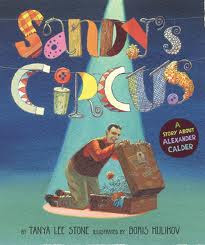
Round Two of Mama Art Docent was fun, fun, fun. On my first day was had studied Diego Rivera. This time the teacher chose Alexander Calder since the class had already started making mobiles as part of a science unit on balance and motion. In social studies they were beginning a unit on Antarctica and so the teacher also requested that we use penguins in the lesson.

We reviewed our last artist and project using our art words (line, shape, color, texture, value, space). Then I read Sandy’s Circus: A Story about Alexander Calder by Tanya Lee Stone. The book is great and the kids loved the illustrations. We kept pausing to discuss the elements of art that the illustrator chose to us, and the kids made lots of interesting and substantive comments tying the illustrations to the story. The kids were excited to find out at the end of the book (*spoiler alert!*) that Calder is credited with inventing the mobile (they had begun studying mobiles the day before). We talked about how artists are inventors and that when they do art they are inventing things. We talked about how art and science go together. Then we followed up by looking at some of the examples of Calder’s mobiles in The Life and Work of Alexander Calder by Adam Schaefer.

For the project, I had bought a second-hand book of penguin photos ($5.00) and sliced out all the pages. I also brought nine photo-laden library books about penguins so that each table group (six kids) had a few to look through as they worked. Each table group got a nice fat stack of beautiful and interesting photos of various penguins. Some kids glued penguin photos to existing pieces of the mobiles they had made the day before. Others ended up reconstructing their mobiles almost completely to accommodate the photos they wanted to use. We talked about how mobiles spin, which means we have to think about what is on either side of the paper. We talked a lot about size, shape and balance. The room was energetic and curious; kids would work, then get distracted, talking with classmates about photos. They kept pulling me aside to show me pictures that they liked. I would ask them to describe what they liked about the photos using their art words, and they would answer – thoughtfully and comfortably using their art words.
In sum, Calder was a huge hit and a great way to pull together art, science and social studies curriculum. I love being a totally-unqualified-yet-excited-about-kids-doing-art Docent and can’t wait to go back next month.

(you can't see the mobile very well - but it was awesome, I promise)



